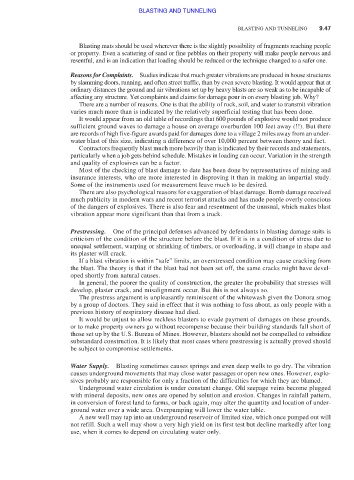Page 447 - Moving the Earth_ The Workbook of Excavation
P. 447
BLASTING AND TUNNELING
BLASTING AND TUNNELING 9.47
Blasting mats should be used wherever there is the slightly possibility of fragments reaching people
or property. Even a scattering of sand or fine pebbles on their property will make people nervous and
resentful, and is an indication that loading should be reduced or the technique changed to a safer one.
Reasons for Complaints. Studies indicate that much greater vibrations are produced in house structures
by slamming doors, running, and often street traffic, than by even severe blasting. It would appear that at
ordinary distances the ground and air vibrations set up by heavy blasts are so weak as to be incapable of
affecting any structure. Yet complaints and claims for damage pour in on every blasting job. Why?
There are a number of reasons. One is that the ability of rock, soil, and water to transmit vibration
varies much more than is indicated by the relatively superficial testing that has been done.
It would appear from an old table of recordings that 600 pounds of explosive would not produce
sufficient ground waves to damage a house on average overburden 100 feet away (!!). But there
are records of high five-figure awards paid for damages done to a village 2 miles away from an under-
water blast of this size, indicating a difference of over 10,000 percent between theory and fact.
Contractors frequently blast much more heavily than is indicated by their records and statements,
particularly when a job gets behind schedule. Mistakes in loading can occur. Variation in the strength
and quality of explosives can be a factor.
Most of the checking of blast damage to date has been done by representatives of mining and
insurance interests, who are more interested in disproving it than in making an impartial study.
Some of the instruments used for measurement leave much to be desired.
There are also psychological reasons for exaggeration of blast damage. Bomb damage received
much publicity in modern wars and recent terrorist attacks and has made people overly conscious
of the dangers of explosives. There is also fear and resentment of the unusual, which makes blast
vibration appear more significant than that from a truck.
Prestressing. One of the principal defenses advanced by defendants in blasting damage suits is
criticism of the condition of the structure before the blast. If it is in a condition of stress due to
unequal settlement, warping or shrinking of timbers, or overloading, it will change in shape and
its plaster will crack.
If a blast vibration is within “safe” limits, an overstressed condition may cause cracking from
the blast. The theory is that if the blast had not been set off, the same cracks might have devel-
oped shortly from natural causes.
In general, the poorer the quality of construction, the greater the probability that stresses will
develop, plaster crack, and misalignment occur. But this is not always so.
The prestress argument is unpleasantly reminiscent of the whitewash given the Donora smog
by a group of doctors. They said in effect that it was nothing to fuss about, as only people with a
previous history of respiratory disease had died.
It would be unjust to allow reckless blasters to evade payment of damages on these grounds,
or to make property owners go without recompense because their building standards fall short of
those set up by the U.S. Bureau of Mines. However, blasters should not be compelled to subsidize
substandard construction. It is likely that most cases where prestressing is actually proved should
be subject to compromise settlements.
Water Supply. Blasting sometimes causes springs and even deep wells to go dry. The vibration
causes underground movements that may close water passages or open new ones. However, explo-
sives probably are responsible for only a fraction of the difficulties for which they are blamed.
Underground water circulation is under constant change. Old seepage veins become plugged
with mineral deposits, new ones are opened by solution and erosion. Changes in rainfall pattern,
in conversion of forest land to farms, or back again, may alter the quantity and location of under-
ground water over a wide area. Overpumping will lower the water table.
A new well may tap into an underground reservoir of limited size, which once pumped out will
not refill. Such a well may show a very high yield on its first test but decline markedly after long
use, when it comes to depend on circulating water only.

